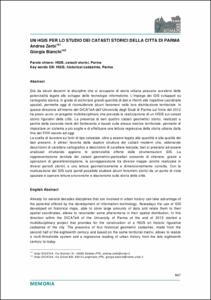Mostra el registre d'ítem simple
Un HGIS per lo studio dei catasti storici della città di Parma
| dc.contributor.author | Zerbi, Andrea |
| dc.contributor.author | Bianchi, Giorgia |
| dc.date.accessioned | 2015-05-07T15:00:40Z |
| dc.date.available | 2015-05-07T15:00:40Z |
| dc.date.issued | 2014-09 |
| dc.identifier.citation | Zerbi, Andrea; Bianchi, Giorgia. Un HGIS per lo studio dei catasti storici della città di Parma. A: International Conference Virtual City and Territory. "9° Congresso Città e Territorio Virtuale, Roma, 2, 3 e 4 ottobre 2013". Roma: Università degli Studi Roma Tre, 2014, p. 947-955. |
| dc.identifier.isbn | 978-88-97524-15-1 |
| dc.identifier.uri | http://hdl.handle.net/2099/16389 |
| dc.description.abstract | Già da alcuni decenni le discipline che si occupano di storia urbana possono avvalersi delle potenzialità legate allo sviluppo delle tecnologie informatiche. L’impiego dei GIS sviluppati su cartografia storica, in grado di archiviare grandi quantità di dati e riferirli alle rispettive coordinate spaziali, permette oggi di riconsiderare alcuni fenomeni nella loro distribuzione territoriale. In questa direzione all’interno del DICATeA dell’Università degli Studi di Parma sul finire del 2012 ha preso avvio un progetto multidisciplinare che prevede la realizzazione di un HGIS sui catasti storici figurativi della città. La presenza di ben quattro catasti geometrici storici, realizzati a partire dalla seconda metà del Settecento e basati sulla stessa matrice territoriale, permette di impostare un sistema a più soglie e di effettuare una lettura regressiva della storia urbana dalla fine del XVIII secolo ad oggi. La scelta di lavorare su fonti di tipo catastale, oltre a essere legata alla quantità e alla qualità dei dati presenti, è altresì favorita dalla duplice struttura dei catasti moderni che, abbinando descrizioni di carattere cartografico a descrizioni di carattere testuale, ben si prestano ad essere analizzati sfruttando appieno le potenzialità offerte dalle strumentazioni GIS. La rappresentazione zenitale dei catasti geometrici-particellari consente di ottenere, grazie a operazioni di georeferenziazione, la sovrapposizione tra diverse mappe (anche realizzate in diversi periodi storici) e una lettura geometricamente e dimensionalmente corretta. Con la realizzazione del GIS sarà quindi possibile studiare alcuni fenomeni storici da un punto di vista spaziale e operare letture sincroniche e diacroniche sulla storia della città. |
| dc.description.abstract | Already for several decades disciplines that are involved in urban history can take advantage of the potential offered by the development of information technology. Nowadays the use of GIS developed on historical maps, able to store large amounts of data and relate them to their spatial coordinates, allows to reconsider some phenomena in their spatial distribution. In this direction within the DICATeA of the University of Parma at the end of 2012 started a multidisciplinary project that provides for the construction of a HGIS on historic figurative cadastres of the city. The presence of four historical geometric cadastres, made from the second half of the eighteenth century and based on the same territorial matrix, allows to realize a multi-thresholds system and a regressive reading of urban history from the late eighteenth century to today. The choice to work on this type of sources, in addition to be linked to the quantity and quality of data present, is also encouraged by dual structure of modern registers that, combining cartographic descriptions with textual descriptions of characters, lend themeselves to be analyzed by exploiting the full potential offered by GIS. The zenithal representation of the detailed-geometric maps allows to obtain, thanks to georeferencing operations, the overlap between different maps (also made in different historical periods) and a geometrically and dimensionally correct reading. With the implementation of GIS will be possible to study some historical phenomena from a spatial point of view and operate synchronic and diachronic readings on the history of the city. |
| dc.format.extent | 9 p. |
| dc.language.iso | ita |
| dc.publisher | Università degli Studi Roma Tre |
| dc.publisher | Centre de Política de Sòl i Valoracions |
| dc.relation.ispartof | International Conference Virtual City and Territory (9è: 2013: Roma) |
| dc.rights | Attribution-NonCommercial-NoDerivs 3.0 Spain |
| dc.rights.uri | http://creativecommons.org/licenses/by-nc-nd/3.0/es/ |
| dc.subject | Àrees temàtiques de la UPC::Urbanisme |
| dc.subject.lcsh | Parma (Italy) -- History |
| dc.subject.lcsh | Geographic information systems |
| dc.subject.lcsh | Parma (Italy) -- Maps |
| dc.subject.other | HGIS |
| dc.subject.other | Catasti storici |
| dc.subject.other | Parma |
| dc.subject.other | Historical cadastres |
| dc.title | Un HGIS per lo studio dei catasti storici della città di Parma |
| dc.type | Conference report |
| dc.subject.lemac | Parma (Itàlia) -- Història |
| dc.subject.lemac | Sistemes d'informació geogràfica |
| dc.subject.lemac | Parma (Itàlia) -- Mapes |
| dc.identifier.doi | 10.5821/ctv.7981 |
| dc.description.peerreviewed | Peer Reviewed |
| dc.rights.access | Open Access |
| local.citation.author | Zerbi, Andrea; Bianchi, Giorgia |
| local.citation.contributor | International Conference Virtual City and Territory |
| local.citation.pubplace | Roma |
| local.citation.publicationName | 9° Congresso Città e Territorio Virtuale, Roma, 2, 3 e 4 ottobre 2013 |
| local.citation.startingPage | 947 |
| local.citation.endingPage | 955 |
| local.ordre | 82 |
Fitxers d'aquest items
Aquest ítem apareix a les col·leccions següents
-
09° Congresso Città e Territorio Virtuale, Roma, 2, 3 e 4 ottobre 2013 [142]
Città, Memoria, Gente


